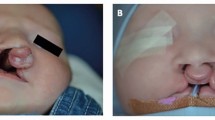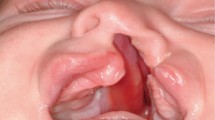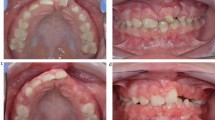Abstract
Although the goal of primary surgery is to avoid the need for secondary surgery, in a proportion of patients this is not always possible. Secondary, or revisional, surgery is frequently undertaken in patients with orofacial clefts and may present a complex and challenging problem for the multidisciplinary team. There are a broad range of functional and aesthetic issues that secondary surgery might aim to address. These include palatal fistulae (that may be symptomatic for air, fluid or food), velopharyngeal insufficiency (typically manifesting with decreased intelligibility or nasal regurgitation), suboptimal cleft lip scars (that can significantly impact upon the psychosocial wellbeing of the patient), and nasal asymmetry (that is frequently accompanied by nasal airway concerns). Unilateral and bilateral clefts are each associated with a characteristic nasal deformity that requires a tailored surgical approach. Suboptimal maxillary growth in repaired orofacial clefts may impact negatively on both appearance and function; surgical correction through orthognathic surgery can be transformational for the patient. The general dental practitioner, cleft orthodontist and restorative dentist all play a critical role in this process.
Key points
-
This paper provides an overview of secondary surgery techniques that are currently used to improve functional and aesthetic outcomes in patients with orofacial clefts.
-
These revisional procedures can be both complex and challenging, and may have a significant psychosocial impact on the patient, so they mandate a multidisciplinary approach.
-
A synopsis of secondary palatal surgery techiques including fistula repair and speech surgery, as well as the utility of orthognathic surgery in addressing maxillary hypoplasia.
This is a preview of subscription content, access via your institution
Access options
Subscribe to this journal
Receive 24 print issues and online access
$259.00 per year
only $10.79 per issue
Buy this article
- Purchase on Springer Link
- Instant access to full article PDF
Prices may be subject to local taxes which are calculated during checkout











Similar content being viewed by others
References
Gart M S, Gosain A K. Surgical Management of Velopharyngeal Insufficiency. Clin Plast Surg 2014; 41: 253-270.
Witzel M A, Rich R H, Margar-Bacal F, Cox C. Velopharyngeal insufficiency after adenoidectomy: an 8-year review. Int J Paediatr Otorhinolaryngol 1986; 11: 15-20.
Sell D, Harding A, Grunwell P. GOS.SP.ASS.'98: an assessment for speech disorders associated with cleft palate and/or velopharyngeal dysfunction (revised). Int J Lang Commun Disord 1999; 34: 17-33.
Kotlarek K J, Sitzman T J, Williams J L, Perry J L. Nonsedated Magnetic Resonance Imaging for Visualization of the Velopharynx in the Paediatric Population. Cleft Palate Craniofac J 2023; 60: 249-252.
De Blacam C, Smith S, Orr D. Surgery for Velopharyngeal Dysfunction: A Systematic Review of Interventions and Outcomes. Cleft Palate Craniofac J 2018; 55: 405-422.
Furlow L T. Cleft palate repair by double opposing Z-plasty. Plast Reconstr Surg 1986; 78: 724-738.
Hill C, Hayden C, Riaz M, Leonard A G. Buccinator Sandwich Pushback: A New Technique for Treatment of Secondary Velopharyngeal Incompetence. Cleft Palate Craniofac J 2004; 41: 230-237.
Sommerlad B C. A Technique for Cleft Palate Repair. Plast Reconstr Surg 2003; 112: 1542-1548.
Collins J, Cheung K, Farrokhyar F, Strumas N. Pharyngeal flap versus sphincter pharyngoplasty for the treatment of velopharyngeal insufficiency: a meta-analysis. J Plast Reconstr Aesthet Surg 2012; 65: 864-868.
Hynes W. Pharyngoplasty by muscle transplantation. Br J Plast Surg 1950; 3: 128-135.
Jackson I T, Silverton J S. The sphincter pharyngoplasty as a secondary procedure in cleft palates. Plast Reconstr Surg 1977; 59: 518-524.
Orticochea M. Construction of a dynamic muscle sphincter in cleft palates. Plast Reconstr Surg 1968; 41: 323-327.
Honig C A. The treatment of velopharyngeal insufficiency after palatal repair. Arch Chir Neerlandicum 1976; 19: 71-81.
Randall P, Whitaker L A, Noone R B, Jones W D. The case for the inferiorly based posterior pharyngeal flap. Cleft Palate J 1978; 15: 262-265.
Collins J, Cheung K, Farrokhyar F, Strumas N. Pharyngeal flap versus sphincter pharyngoplasty for the treatment of velopharyngeal insufficiency: a meta-analysis. J Plast Reconstr Aesthet Surg 2012; 65: 864-868.
Abdali H, Yaribakht M. Assessment of outcomes and complications of posterior pharyngeal wall augmentation with dermal fat graft in patients with Velopharyngeal Insufficiency (VPI) after primary cleft palate repair: A pilot study. JPRAS Open 2018; 19: 6-18.
Hardwicke J T, Landini G, Richard B M. Fistula incidence after primary cleft palate repair: a systematic review of the literature. Plast Reconstr Surg 2014; DOI: 10.1097/PRS.0000000000000548.
Bykowski M R, Naran S, Winger D G, Losee J E. The Rate of Oronasal Fistula Following Primary Cleft Palate Surgery: A Meta-Analysis. Cleft Palate Craniofac J 2015; DOI: 10.1597/14-127.
Smith D, Vecchione L, Jiang S et al. The Pittsburgh Fistula Classification System: a standardized scheme for the description of palatal fistulas. Cleft Palate Craniofac J 2007; 44: 590-594.
Schultz R C. Management and timing of cleft palate fistula repair. Plast Reconstr Surg 1986; 78: 739-747.
Kirschner R E, Cabiling D S, Slemp A E, Siddiqi S, La Rossa D D, Losee J E. Repair of oronasal fistulae with acellular dermal matrices. Plast Reconstr Surg 2006; 118: 1431-1440.
Ohsumi N, Onizuka T, Ito Y. Use of a free conchal cartilage graft for closure of a palatal fistula: an experimental study and clinical application. Plast Reconstr Surg 1993; 91: 433-440.
Zhao Z, Li S, Yan Y et al. New buccinator myomucosal island flap: anatomic study and clinical application. Plast Reconstr Surg 1999; 104: 55-64.
Ashtiani A K, Emami S A, Rasti M. Closure of complicated palatal fistula with facial artery musculomucosal flap. Plast Reconstr Surg 2005; 116: 381-388.
Guerrero-Santos J, Altamirano J T. The use of lingual flaps in repair of fistulas of the hard palate. Plast Reconstr Surg 1966; 38: 123-128.
Guerrero-Santos J, Fernandez J M. Further experience with tongue flap in cleft palate repair. Cleft Palate J 1973; 10: 192-202.
Chen H C, Ganos D L, Coessens B C, Kyuotoku S, Noordhoff M S. Free forearm flap for closure of difficult oronasal fistulas in cleft palate patients. Plast Reconstr Surg 1992; 90: 757-762.
Ninkovic M, Hubli E H, Schwabegger A, Anderl H. Free flap closure of recurrent palatal fistula in the cleft lip and palate patient. J Craniofac Surg 1997; 8: 491-495.
Aufricht G. Presentation at the Annual Meeting of the American Society of Maxillo-Facial Surgeons. Philadelphia. 1955.
Broadbent T R, Woolf R M. Cleft lip nasal deformity. Ann Plast Surg 1984; 12: 216.
Gillies H, Millard D R. The Principles and Art of Plastic Surgery. Boston: Little Brown, 1966.
Guyuron B. MOC-PS CME Article: Late Cleft Lip Nasal Deformity. Plast Reconstr Surg 2008; 121: 1-11.
Calvo-Henríquez C, Neves J C, Arancibia-Tagle D et al. Does paediatric septoplasty compromise midfacial growth? A systematic review. Eur Arch Otorhinolaryngol 2020; 277: 1565-1574.
Monson L A, Khechoyan D Y, Buchanan E P, Hollier L H. Secondary Lip and Palate Surgery. Clin Plastic Surg 2014; 41: 301-309.
Cohen S R, Corrigan M, Wilmot J, Trotman C A. Cumulative operative procedures in patients aged 14 years and older with unilateral or bilateral cleft lip and palate. Plast Reconstr Surg 1995; 96: 267-271.
DeLuke D M, Marchand A, Robles E C, Fox P. Facial growth and the need for orthognathic surgery after cleft palate repair: literature review and report of 28 cases. J Oral Maxillofac Surg 1997; 55: 694-698.
Good P M, Mulliken J B, Padwa B L. Frequency of Le Fort I osteotomy after repaired cleft lip and palate or cleft palate. Cleft Palate Craniofac J 2007; 44: 396-401.
McComb R W, Marrinan E M, Nuss R C, Labrie R A, Mulliken J B, Padwa B L. Predictors of velopharyngeal insufficiency after Le Fort I maxillary advancement in patients with cleft palate. J Oral Maxillofac Surg 2011; 69: 2226-2232.
Schultz K P, Braun T L, Hernandez C et al. Speech Outcomes After LeFort I Advancement Among Cleft Lip and Palate Patients. Ann Plast Surg 2019; 82: 174-179.
Dentino K M, Marrinan E M, Brustowicz K, Mulliken J B, Padwa B L. Pharyngeal Flap Is Effective Treatment for Post Maxillary Advancement Velopharyngeal Insufficiency in Patients With Repaired Cleft Lip and Palate. J Oral Maxillofac Surg 2016; 74: 1207-1214.
Jackson O A, Mehendale F V. Speech Surgery and Treatment of Velopharyngeal Insufficiency. In Swanson J W (ed) Global Cleft Care in Low-Resource Settings. Cham, Springer, 2021.
42. Smith D M, Vecchione L, Jiang S et al. The Pittsburgh Fistula Classification System: a standardized scheme for the description of palatal fistulas. Cleft Palate Craniofac J 2007; 44: 590-594.
Denadai R, Lo L J. State of the Art in Secondary Cleft Rhinoplasty: Comprehensive Technical Details and Deformity-Specific Approach. In Denadai R, Lo L J (eds) Current Concept in Cleft Surgery. Singapre: Springer, 2022.
Author information
Authors and Affiliations
Contributions
All three authors contributed to the concept, content and preparation of this manuscript.
Corresponding author
Ethics declarations
The authors declare no conflicts of interest. Written consent to publish was obtained for Figures 10 and 11.
Rights and permissions
About this article
Cite this article
Martin, S., Van Eeden, S. & Swan, M. Secondary surgery techniques to optimise functional and aesthetic outcomes in orofacial clefting. Br Dent J 234, 899–905 (2023). https://doi.org/10.1038/s41415-023-6001-8
Received:
Revised:
Accepted:
Published:
Issue Date:
DOI: https://doi.org/10.1038/s41415-023-6001-8
This article is cited by
-
An introduction to the UK care pathway for children born with a cleft of the lip and/or palate
British Dental Journal (2023)



